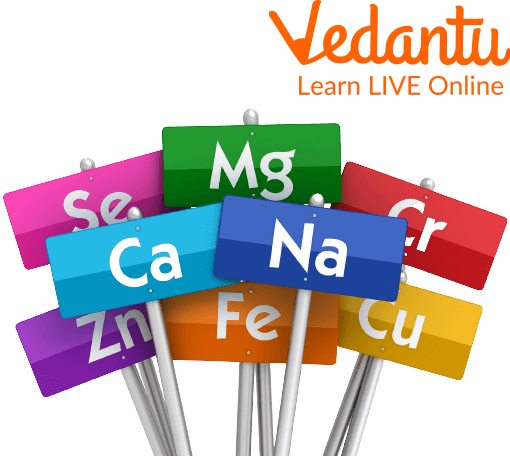




What Are Minerals? Definition, Properties, and Everyday Examples
Have you ever noticed how breakfast cereal commercials on TV usually emphasise vitamins and minerals? But eating isn't the first thing that comes to mind when you think about minerals. Minerals, such as iron and quartz, aren't found on the earth? Yes, but some elements are found in low contents in meals, such as meat, which is a rich source of iron.
Minerals help your body grow and stay healthy. Minerals are used by the body for a variety of purposes, including bone formation and nerve impulse transmission. Some elements are even used to manufacture hormones or keep the heart beating normally. In this we are going to learn about different types of minerals and their properties with examples.

Minerals
What is Mineral?
Minerals in food are the elements present in food that are required by our body to develop and function properly. We can draw from the given definition that minerals are inorganic compounds necessary for the human body to function properly. To produce healthy bones and muscles, the human body requires varied amounts of minerals on a regular basis. It also aids in the maintenance of many body functions. As a result, humans receive these nutrients through eating mineral-rich meals.
Certain nutritional deficiency disorders can develop when the body does not acquire adequate minerals. Mineral deficiency illnesses include goitre, osteoporosis, anaemia, hypomagnesaemia, and diarrhoea. In the below image we can see some of the minerals examples such as apple, orange, egg, carrot, tomato and many more.

Mineral Riched Foods
Types of Minerals
There are two types of minerals. They are as follows:
Macrominerals
These are the minerals that must be consumed in relatively large quantities. As a result, they are also known as major minerals.
Sodium, calcium, chloride, magnesium, potassium, phosphorus, and sulphur are examples of macrominerals. These minerals are essential for the body's proper functioning and metabolism. Because our bodies cannot create these minerals, they must be received from a food source.
A lack of these minerals has serious consequences for one's health. Calcium insufficiency, for example, weakens the skeletal system, increasing the risk of fractures. Iodine shortage causes goitre and other hormonal abnormalities, while salt deficit causes hyponatremia.
Microminerals
These minerals, often known as trace minerals, are required in significant quantities. As a result, they are sometimes known as minor minerals. Iron, copper, iodine, zinc, manganese, fluoride, cobalt, and selenium are some examples of trace minerals.
Mineral poisoning is caused when these trace minerals are consumed in large quantities. Acute selenium toxicity, for example, is noticed when a person overdoses on nutritional supplements. It can induce nausea, discolouration or brittleness of the nails, hair loss, and diarrhoea.
Properties of Minerals
Following are some of the mineral properties with their function and food sources:
Minerals- Sources and Functions
Facts About Minerals in Food
Following are the facts about minerals in food:
According to the 2015-2020 Dietary Guidelines for Americans, vitamin D, calcium, potassium, iron, and dietary fibre are considered nutrients of public health concern because their low intakes are associated with negative health conditions.
About 99 per cent of the human body is made up of 6 elements: two of which include calcium and phosphorus!
Summary
The minerals in food are the elements present in food that are required by our body to develop and function properly. They include calcium, magnesium, potassium, sodium, etc. There are two different types of minerals, i.e. macrominerals and microminerals. Microminerals include zinc, iron, copper, etc. While major minerals include calcium, phosphorus, magnesium, etc. All minerals are required for excellent growth and development of the body.
FAQs on Top 10 Important Facts About Minerals Every Student Should Know
1. What exactly is a mineral?
A mineral is a naturally occurring, solid substance that has a specific chemical composition and a crystal structure. This means it is not man-made, it is not a liquid or gas, and its atoms are arranged in a repeating pattern. For example, quartz and halite (rock salt) are minerals.
2. Is the common salt we use at home a mineral?
Yes, salt is a mineral. Its mineral name is halite. It is a naturally occurring crystalline solid with the chemical formula NaCl (sodium chloride). The salt you find in a salt mine is a mineral, and the table salt in your kitchen originally came from these natural mineral deposits.
3. What is the main difference between a mineral and a rock?
The main difference is that a mineral has a single, uniform chemical makeup and crystal structure. A rock, on the other hand, is typically a mixture of two or more different minerals bonded together. You can think of minerals as the 'ingredients' and rocks as the 'cake' made from those ingredients.
4. How do scientists identify different types of minerals?
Scientists identify minerals by observing their unique physical properties. They check for several clues, including:
- Colour: The visible colour of the mineral.
- Lustre: How it reflects light (e.g., shiny like metal, glassy, or dull).
- Hardness: How easily it can be scratched, often tested using the Mohs scale.
- Streak: The colour of the powder it leaves when rubbed on a rough surface.
- Crystal Shape: The natural geometric shape of its crystals.
5. Why are minerals so important in our daily lives?
Minerals are essential building blocks for countless items we use every day. Without them, our lives would be very different. For instance:
- Graphite, a soft mineral, is used to make the lead in your pencil.
- Iron, extracted from minerals like hematite, is used to make steel for cars, bridges, and buildings.
- Quartz is a crucial mineral used in watches and computers due to its electrical properties.
- Fluorite is a mineral added to toothpaste to help strengthen teeth and prevent cavities.
6. Is water considered a mineral?
Water in its liquid form is not a mineral because, by definition, a mineral must be solid. However, naturally formed ice, like in a glacier or a frozen pond, is considered a mineral. It is solid, occurs naturally, and has a specific crystal structure. Ice cubes from a freezer are not minerals because they are man-made.
7. Are all shiny stones you find on the ground valuable gems?
No, not all shiny stones are valuable gems. While famous gems like diamonds, rubies, and sapphires are minerals, their high value comes from their exceptional beauty, rarity, and hardness. Many common minerals, such as quartz and mica, can be very shiny but are not considered precious gems because they are much more abundant and easier to find.





















